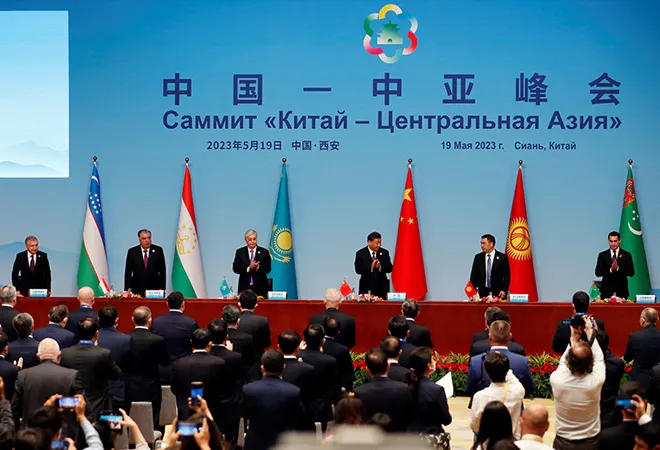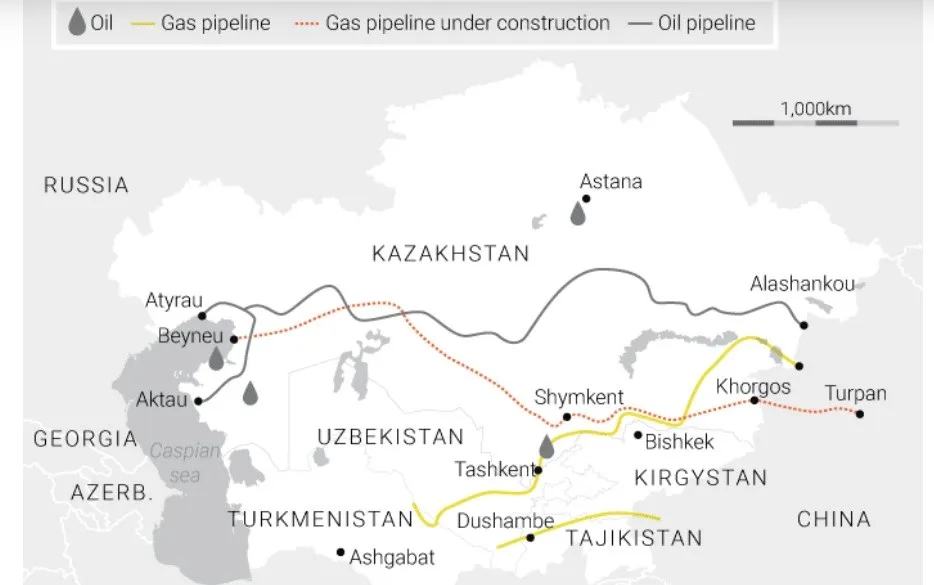
On 19 May,
President Xi Jinping hosted the China-Central Asia Summit (C+C5), in Xi’an, China’s historic city. The summit was attended by the heads of state of Kazakhstan, Uzbekistan, Kyrgyzstan, Tajikistan, and Turkmenistan. Xi’an was the starting point of the ancient Silk Road—a network of trade routes ning over 64,000 kilometres connecting the Eastern and Western civilisations. Driven by Xi’s policy of “
good-neighbourliness and friendship”, Beijing used the C+C5 summit to cement and boost its strategic cooperation with Central Asia,
specifically for the much-hyped Belt and Road Initiative (BRI), Global Security Initiative, and
Global Civilisation Initiative.
Concerned by the Russia-Ukraine conflict, the Central Asian Republics (CARs) are trying to reduce their traditional security dependence on Moscow, which is now increasingly seen as a threat to regional stability, territorial integrity, and sovereignty. Unnerved by the prospect of Russia—which enjoys substantial economic and political influence over the region—turning against them, none of the CARs have endorsed Moscow's actions in Ukraine. Anticipating risks to their sovereignty and territorial integrity, CARs are diversifying their foreign policy to minimise the Kremlin's influence. Kazakhstan even
refused to recognise eastern Ukraine and accused Russian politicians of sowing discord between Moscow and Astana. Kazakhstan and Uzbekistan also reaffirmed the
territorial integrity of Ukraine and sent
humanitarian assistance to Kyiv against Moscow’s expectations. Under these peculiar conditions,
Xi Jinping reiterated during the summit that the security, sovereignty, independence, and territorial integrity of CARs must be upheld.
Kazakhstan and Uzbekistan also reaffirmed the territorial integrity of Ukraine and sent humanitarian assistance to Kyiv against Moscow’s expectations.
But considering Russia’s overwhelming influence, distancing themselves from the Kremlin will not be easy for the Central Asian leaders. Therefore, it was no surprise that, despite criticising Russia’s actions in Ukraine, all five Central Asian leaders joined President Vladimir Putin for the 9
May Victory Day Parade at Red Square on
short notice.
The underlying tension between the CARs and Russia has given China an opportunity to use its geopolitical, geostrategic, and geoeconomic clout, backed by proactive and targeted diplomacy, to strengthen its hegemonic pursuits in the region.
China's policy in Central Asia after 1991
The geostrategic position of Central Asia places it at the heart of Eurasia and serves as a pivot for geopolitical transformations within the “
world island”. In addition, endowed with natural resources and offering a huge market potential, Central Asia has emerged as the “global chessboard” for major powers. For China, the contested history and centrifugal tendencies in its Northwest province of Xinjiang and its close cultural and historical affinity with CARs present a worrying scenario, especially regarding the pro-Uyghur sentiments in the region.
China accorded top priority to investments in the region’s hydrocarbon reserves to diversify its energy imports and meet the growing energy demand within China.
To minimise Central Asia’s influence on the Uyghurs and to push its hegemonic agenda, Beijing started to steadily gain economic clout by extending substantial loans and investments in CARs after 1991. China accorded top priority to investments in the region’s hydrocarbon reserves to diversify its energy imports and meet the
growing energy demand within China.
Lt. Gen. Liu Yazhou, a high-ranked Chinese Communist Party official, said that the hydrocarbon reserves were “
a rich piece of cake given to today's Chinese people by Heaven.” Beijing built many cross-country pipelines to import gas from Turkmenistan, as well as oil and gas from Kazakhstan and other CARs. The state-owned China National Petroleum Cooperation (CNPC) has invested more than
US$45 billion in Kazakhstan's oil and gas sector. Turkmenistan supplied
34 billion cubic meters of natural gas to China in 2021, and, in 2022, the increased gas imports were valued at
US$ 9.2 billion. Today, China
receives 30 percent of its natural gas imports through pipelines connecting Beijing, Shanghai, and other cities with Central Asia, as shown in the map below. In return, Beijing has gotten a significant assurance for its internal security; it got the CARs to
ban all Uyghur organisations and put Uyghur Muslims living in CARs under increased surveillance.
 Source: The Central Asian gas pipeline (scmp.com)
Source: The Central Asian gas pipeline (scmp.com)
Beijing also used the Central Asian expanse to build connectivity with Russia, Eurasia, and Europe. China intensified efforts to revive the old Silk Road and invested heavily in building railway lines, roads, and other infrastructure, for example,
Khorgos, a dry port located at the border between Kazakhstan and Xinjiang’s Ili Kazak autonomous prefecture. Trains carrying cargo from China started operations across the dry port
after the tracks from both sides of the Khorgos were connected in 2012.
China also established a military base at the strategic Wakhan corridor in Tajikistan.
Under Xi, China revamped its Central Asian policy, making the region the linchpin for Beijing's “March West” strategy. Since the launch of the BRI in 2013, China has emerged as the strongest player in the region, with trade increasing from US$ 660 million in 1992 to China has also used multilateral fora to increase its influence over the region.
China intensified efforts to revive the old Silk Road and invested heavily in building railway lines, roads, and other infrastructure.
The China-Kyrgyzstan-Uzbekistan (CKU) railway line, which was agreed upon on the sidelines of the SCO summit in 2022 at Samarkand, is designed to shorten the route to Europe and bypassed sanctions-hit Russia. The total length of the proposed
railway line is 523 km, which includes 213 km in China, 260 km in Kyrgyzstan and 50 km in Uzbekistan. Xi also signed
a US$ 15 billion trade, investment, and economic cooperation with Uzbekistan. Negating Kazakhstan’s concerns about its territorial integrity after the Russia-Ukraine conflict, Xi said it would
not tolerate encroachment on Kazak territory.
The era of
cooperative hegemony in Central Asia—where Moscow is a security guarantor and Beijing is an investor and economic power—has changed, and CARs are keen to exercise a multi-vector foreign policy to get more countries involved in the region. The CARs are also looking at new regional markets to diversify their energy exports. In 2021, Kazakhstan exported
65.7 million tons of oil and oil products, of which only 3.6 million tons were imported to China. In contrast, EU countries, including France, Italy, and the Netherlands, received more. Similarly,
Turkmenistan and Uzbekistan are also looking for new diversified markets other than China and Russia. This explains why President Xi stressed expediting the construction of
Line D of the China-Central Asia pipeline and proposed energy industrial chains and energy development partnerships.
Born as independent nations following the disintegration of the erstwhile Soviet Union, the people of the CARs still consider Russia a soft power based on cultural and linguistic similarities and economic and security dependencies.
Born as independent nations following the disintegration of the erstwhile Soviet Union, the people of the CARs still consider Russia a soft power based on cultural and linguistic similarities and economic and security dependencies. Western sanctions on Russia following the Ukraine crisis has led to an increase in exports from CARs to Russia. Even
remittances from Russia to Uzbekistan doubled to US$17 billion in 2022.
On the other hand, Beijing is more popular among the CAR’s ruling elites as China’s substantial investments have helped pacify the growing resentment amongst the masses and prevented any uprising against the authoritarian regimes. Of late, however, the region has seen sporadic anti-China protests for alleged
grabs,
imprisonment of millions of Muslim minorities in Xinjiang, and lack of job opportunities for locals in Chinese-funded projects. Since 2015, CARs have seen more than
150 anti-Chinese protests, particularly in Kyrgyzstan, Tajikistan, and Kazakhstan.
Against such a volatile regional backdrop, the CCP used the C+C5 Summit in Xi'an to inject new momentum into Xi’s pet BRI connectivity projects and
Global Civilisation Initiative—to deepen everlasting friendship and deepen mutual cultural learning for close affinity and shared conviction. Importantly, Xi tried to project Beijing as a partner and not a hegemon during the summit. It remains to be seen how leaders of CARs will keep their multi-vector foreign policy intact without becoming China’s colony.
Ayjaz Wani is a Fellow with the Strategic Studies Programme at the Observer Research Foundation.
The views expressed above belong to the author(s). ORF research and analyses now available on Telegram! Click here to access our curated content — blogs, longforms and interviews.



 On 19 May,
On 19 May, 
 PREV
PREV


